Winter Lawn Care: A Comprehensive Guide to Preparing Your Turf for the Colder Months

When the winter months approach, it's not just your home that requires special attention; your lawn also needs some TLC to withstand the challenges that come with colder weather. Winterizing your lawn is a crucial step in maintaining its health and ensuring it thrives when spring rolls around.
In this guide, we'll take you through the essential steps to prepare your lawn for winter, from assessing its unique needs to performing necessary maintenance tasks.
Why Winterizing Your Lawn Matters
Winter can be harsh on your lawn. As temperatures drop and snow accumulates, your grass, soil, and plants face various challenges, including freezing temperatures, moisture stress, and the potential for pest and disease infestations. Neglecting your lawn during this season can lead to a lackluster and damaged yard come springtime.
Assessing Your Lawn's Needs
Before embarking on your winterization journey, it's essential to understand that not all lawns are created equal. Different grass types, soil compositions, and environmental conditions can significantly influence how you should prepare your lawn for the winter.
Understanding Your Specific Grass Type
Cool-season vs. warm-season grasses: The type of grass in your lawn plays a vital role in how it behaves during winter. Cool-season grasses like Kentucky bluegrass and Fescue thrive in colder regions, while warm-season grasses such as Bermuda and Zoysia prefer warmer climates. Knowing your grass type helps you tailor your winterization plan accordingly.
Hardiness zone: Determine your USDA hardiness zone, as this will give you insights into the expected winter conditions in your area. Different zones have varying temperature ranges, which impact how your lawn should be cared for during the winter months.
Soil Testing and Analysis
We highly recommend testing your soil with the MySoil Home Testing Kit as it analyzes 13 plant available nutrient levels, including nitrogen and pH (nitrogen (N) (nitrate and ammonium), phosphorus (P), potassium (K), calcium (Ca), magnesium (Mg), sulfur (S), iron (Fe), manganese (Mn), boron (B), copper (Cu), zinc (Zn), and sodium (Na)). It will help you choose the right fertilizer for your lawn based on your soil test results. Soil test data will also tell you whether you need to raise or lower your soil pH.
Soil type: Understanding your soil type (sandy, loamy, clayey, etc.) is crucial for proper lawn care. Different soils have different drainage capabilities and nutrient-holding capacities, influencing how you should approach winterization.
pH levels: Test your soil's pH levels. Most lawns prefer a slightly acidic pH between 6 and 7. Adjusting the pH, if necessary, can help your grass absorb nutrients more efficiently. If you find that your lawn has a low pH, we recommend applying MAG-I-CAL® PLUS Soil Food for Lawns to raise it, or if it has a high pH, MAG-I-CAL® PLUS Soil Food for Lawns will lower the pH.
Nutrient levels: Soil tests can reveal nutrient deficiencies or excesses. Addressing these imbalances through fertilization ensures your lawn gets the nutrients it needs to survive the winter and thrive in the spring.
Related reading: How Soil Tests for Your Lawn Can Save You Money
Identifying and Addressing Problem Areas
Bare spots: Locate any bare spots or thin areas in your lawn. These areas are more susceptible to winter damage and may require special attention.
Compacted soil: Compacted soil can impede water infiltration and root growth. Consider aerating these areas to alleviate compaction.
Shade and sun exposure: Observe how sunlight falls on your lawn. Areas with limited sunlight will likely go dormant sooner and come out of dormancy later in the spring.
Drainage issues: Identify areas prone to waterlogging or poor drainage. Proper drainage is essential to prevent ice buildup and root rot during the winter.
By taking the time to assess your lawn's specific conditions, you'll be better prepared to create a winterization plan tailored to your unique circumstances.
Lawn Mowing

As the temperatures drop and winter approaches, proper lawn mowing practices become critical components of winterizing your lawn.
Contrary to what you might think, winter lawn care isn't just about letting your grass grow longer to keep it warm. It involves strategic mowing to ensure your lawn remains healthy throughout the colder months.
Proper Mowing Techniques for Winter
Gradual reduction: In the weeks leading up to winter, gradually reduce the height at which you mow your grass. Mowing it slightly shorter than your regular summer height (about 2 to 2.5 inches for most cool-season grasses) can help prevent snow mold and other issues.
Avoid scalping: While lowering your mowing height is good practice, avoid scalping your lawn in winter. Avoid removing more than one-third of the grass blade in a single mowing session.
Keep blades sharp: Ensure your lawnmower blades are sharp. Dull blades can tear the grass rather than cut it cleanly, leading to brown, frayed tips.
Collect clippings: During your last mowing sessions leading to winter, collect grass clippings. Leaving them on the lawn during winter can encourage disease and matting under snow cover.
Determining the Right Grass Height
Choose height based on grass type: Different grass types have different ideal winter heights. Refer to guidelines specific to your grass type and hardiness zone. For example, cool-season grasses like tall fescue should be kept taller than warm-season varieties.
Avoid extreme height reductions: While shorter grass is beneficial in winter, don't cut it too short. Leaving some leaf surface helps the grass continue photosynthesis, even during winter.
Dealing with Fallen Leaves and Debris
Leaf removal: Remove fallen leaves promptly. A thick layer of leaves can smother your lawn, inhibiting growth and promoting disease. Use a leaf blower or rake to clear them away.
Debris cleanup: Remove debris, sticks, or branches from your lawn. These objects can damage your lawnmower and create uneven surfaces.
Aerate if necessary: If your lawn has heavy thatch buildup (a layer of dead grass and organic matter), consider aerating before winter. Aeration helps improve soil and air circulation, reducing the risk of snow mold.
By following these mowing and other lawn care practices, you'll create an ideal environment for your lawn to withstand the challenges of winter.
Providing Nutrients for Your Winter Lawn
While some people like to regularly fertilize their lawn in winter, we don’t recommend it. It can create conditions that promote fungus, such as snow mold, and other problems later on in the growing season. Besides, dormant grass has far lower nutrient demands, so it can be a waste of time, money, and fertilizer products. However, winterizing your lawn with the right nutrients will strengthen its roots, enhance cold tolerance, and ensure it emerges healthy and vibrant in the spring.
Choosing the Right Products for Winter
One of the best products to use on your lawn in the colder months is Mirimichi Green CarbonizPN-G™. It is a granular carbon and compost biostimulant that contains premium organics, biochar, and a soil microbial package. It works by improving microbial conditions in the soil, allowing your fertilizer to work better.
As mentioned earlier, we don’t recommend winter fertilization, especially if you have warm-season grass, as it can encourage spring dead spot disease development in cold conditions. If you have cool-season grass such as Kentucky bluegrass, perennial ryegrass, and turf type tall fescue, you could use Stress 12-0-24 - Lebanon Country Club Fertilizer, as it can be applied in cooler conditions as long as your grass is still growing.
Understanding NPK ratios: Fertilizers are labeled with three numbers representing their nitrogen (N), phosphorus (P), and potassium (K) content, known as the NPK ratio. For winterization, choose a fertilizer with a lower nitrogen content and higher potassium content. Stress 12-0-24 with 24% potassium is an excellent choice.
Timing for Winter Nutrient Application
CarbonizPN-G™ is an organic product that can be applied monthly as long as the ground isn’t frozen. It is safe to use on all grass types, and one bag will cover up to 4,000 sq ft of lawn. There is no risk of burning the soil or grass using it, and you can’t really apply too much.
If you want to fertilize your lawn before the weather turns much colder, the ideal time is late fall, typically around late October to early November. This timing allows your grass to absorb the nutrients and build up its energy reserves before the colder months.
Avoid fertilizing too late in the season, as it may promote new, tender growth that won't have time to harden off before winter. We recommend waiting until late February or early March before you resume your fertilizer application schedule, as your grass will come out of dormancy around that time.
Aeration and Dethatching

Aeration and dethatching are critical lawn care practices that can significantly impact the health of your lawn during the winter months. These processes help improve soil aeration, reduce thatch buildup, and ensure your grass has access to air, water, and nutrients.
Why Aeration Is Crucial for Winter Readiness
Enhanced soil aeration: Aeration involves perforating the soil with small holes, allowing for better air circulation and root growth. Improved soil aeration is particularly essential during the winter when compacted soil can limit root expansion.
Water infiltration: Aeration helps water penetrate the soil more effectively, reducing the risk of water runoff and allowing the roots to access moisture during dry winter periods.
Reduced compaction: Over time, soil can become compacted, making it difficult for grass roots to penetrate and access essential nutrients. Aeration alleviates compaction, promoting healthier root development.
Tools and Methods for Aeration
Aeration equipment: There are various aeration tools available, including spike aerators and plug aerators. Plug aerators, which remove small plugs of soil, are generally more effective in relieving soil compaction.
Timing: The best time for cool-season grass aeration is late summer or early fall. However, if you missed this window, aeration is also beneficial in early spring as new growth begins.
Aeration depth and frequency: Aerate to a depth of 2-3 inches and make multiple passes if necessary. Frequency depends on the condition of your lawn but is typically recommended every 1-3 years.
Related reading: How to Core Aerate Your Lawn
Addressing Thatch Buildup
Understanding thatch: Thatch is a layer of dead grass, roots, and organic matter that accumulates on the soil surface. While some thatch is normal and beneficial, excessive thatch can impede water and nutrient absorption.
Dethatching methods: Dethatching can be done using specialized dethatching machines or dethatching rakes. These tools help remove excess thatch and encourage a healthier lawn. It’s important to not be too aggressive when reducing lawn thatch levels. In most cases a scarifier or turf rake can be used to reduce thatch levels in a less aggressive manner.
Timing: Dethatching is best done in late spring for warm-seaon grass or early fall for cool-season grass when the grass is actively growing. Avoid dethatching in the heat of summer or during periods of drought.
By managing thatch levels throughout the year as part of your winterization plan, you'll create an environment where your lawn can thrive. These practices improve soil health, enhance root development, and set the stage for a beautiful and resilient lawn in the coming spring.
Overseeding and Reseeding
Overseeding and reseeding can be important steps in preparing your cool-season lawn for winter, especially if you want to ensure a thick and lush lawn when spring arrives. These practices involve introducing new grass seed to your existing lawn to promote healthy growth, fill in bare spots, and combat the effects of wear and tear.
Benefits of Overseeding in Preparation for Winter
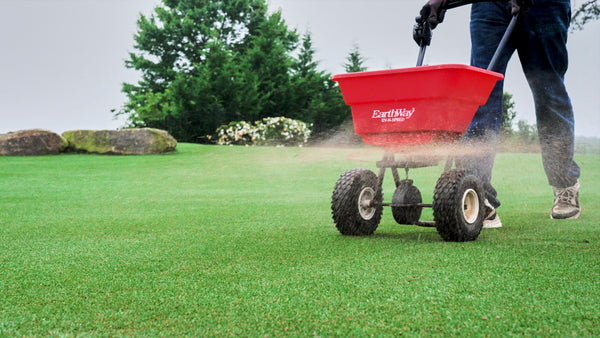
Thicker grass: Overseeding introduces new grass to your lawn, increasing its overall density. A thicker lawn is better equipped to withstand winter stresses and recover from damage.
Improved resistance: New grass varieties may be more resistant to diseases, pests, and harsh winter conditions, making your lawn more resilient.
Enhanced appearance: Overseeding can rejuvenate the appearance of your lawn, giving it a fresh, vibrant look.
Selecting the Appropriate Grass Seed
Match grass types: Choose grass seed varieties that match the existing grass types in your lawn for a cohesive and visually appealing yard.
Consider climate: Select grass seed suitable for your climate and hardiness zone. Some varieties are better equipped to handle cold temperatures, while others thrive in warmer regions.
Seed quality: Invest in high-quality grass seed to increase the chances of successful germination and establishment.
Proper Overseeding Techniques
Timing: The best time for overseeding cool-season lawns is in the late summer or early fall, typically around the same time as aeration. This timing allows new grass to establish roots before winter.
Preparation: Before overseeding, mow your lawn slightly shorter than usual and remove debris or thatch. This provides a clean slate for the new grass seed to make contact with the soil.
Seed distribution: Use a broadcast spreader to evenly distribute the grass seed across your lawn. Pay special attention to thin or bare areas.
Fertilize and water: After overseeding, apply a starter fertilizer and water the lawn thoroughly. Keep the soil consistently moist until the new grass is established.
Reseeding for Problematic Areas
Identify bare or thin spots: Inspect your yard for areas with thin or no grass coverage. These are prime candidates for reseeding.
Preparation: Like overseeding, prepare the soil by mowing and clearing debris. Loosen the topsoil to create a better seedbed.
Reseeding process: Apply grass seed to the problematic areas and lightly rake the soil to ensure good seed-to-soil contact. Water thoroughly and maintain soil moisture until germination occurs.
Overseeding and reseeding are valuable practices that breathe new life into your lawn, making it more resilient and aesthetically pleasing. These steps, combined with proper fertilization and aeration, will help your lawn thrive throughout the winter months and emerge stronger in the spring.
Related reading: Which Grass Type Is Best Suited to My Area?
Lawn Irrigation
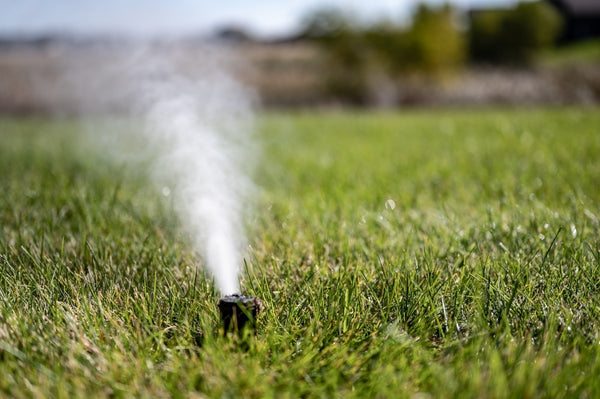
Winterize your irrigation sprinkler system by
blowing pressurized air through to clear out water
Proper lawn irrigation plays a crucial role in winterizing your lawn. While you might think that watering your lawn is primarily a concern for warmer seasons, maintaining adequate moisture levels in the soil during the winter is equally important.
Adjusting Watering Schedule for Colder Weather
Reduced watering frequency: As temperatures drop, your lawn's water requirements decrease. Adjust your irrigation schedule to water less frequently but more deeply. Deep, infrequent watering encourages deep root growth, which is beneficial for winter survival.
Timing: Water your lawn during the morning hours when temperatures are higher. Avoid evening watering, as it can lead to extended periods of wetness that promote disease.
Preventing Frozen Pipes and Sprinkler Systems
Drain irrigation lines: Before the first freeze, drain your irrigation lines to prevent water from freezing and damaging the system. This may involve using a compressor to blow out any remaining water.
Protect sprinkler heads: Insulate or protect above-ground sprinkler heads to prevent freezing and damage. Some sprinkler systems have built-in freeze protection features.
Shutoff water supply: Shut off the water supply to your outdoor faucets and irrigation systems to prevent freezing and pipe damage.
Drainage Considerations
Address drainage issues: Proper drainage is essential to prevent waterlogged soil and ice buildup during the winter. Ensure your lawn has adequate drainage, especially in low-lying areas.
Install drainage solutions: Consider installing drainage solutions such as French drains or dry wells in areas prone to water accumulation.
Remove obstructions: Keep your lawn free of debris, leaves, and other obstructions that can impede drainage and cause water to pool.
By adjusting your lawn irrigation practices for colder weather and taking steps to prevent frozen pipes and sprinkler systems, you can ensure your lawn receives the right amount of moisture without risking damage to your irrigation system. Adequate moisture management is key to protecting your grass from winter stress.
Related reading: Muddy Backyard Solutions: How to Help Drainage for Lawns
Protecting Your Lawn from Pests and Diseases
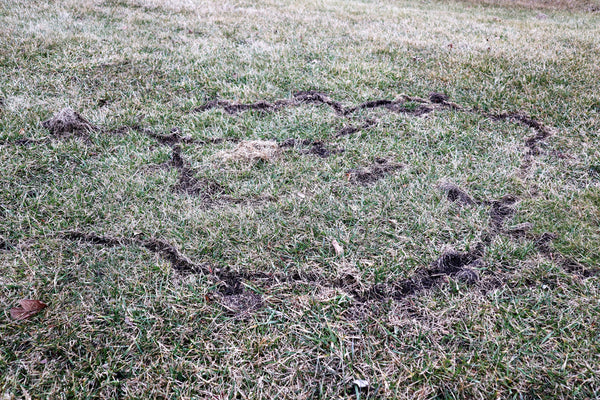
Winter may seem like a time when pests and diseases are less of a concern for your lawn, but it's essential to remain vigilant. Cold weather can create conditions that some pests and diseases thrive in, and the damage they cause can linger into the spring.
Identifying Common Winter Lawn Pests
Snow mold: Snow mold is a common fungal disease that appears in cold, wet conditions. It can cause dead, matted patches on your lawn. Avoid piling snow on your lawn to prevent snow mold.
Voles: Voles are small rodents that can create runways under the snow, damaging your grass. Keep your lawn clear of debris that provides cover for voles, and consider physical barriers like fencing.
Deer and rabbits: In some regions, deer and rabbits can be a problem during winter. Use fencing or other deterrents to protect your lawn from their grazing.
Strategies for Pest Control in the Winter
Fall pest control: Implement pest control measures in the fall to reduce pest populations before winter arrives. This can include treatments for grubs or other lawn-damaging insects.
Raking and cleanup: Remove fallen leaves and debris from your lawn. These materials can provide shelter for pests during the winter.
Snow removal: Clear snow promptly from your lawn to prevent pests like voles from tunneling and damaging the grass underneath.
Preventing Winter Lawn Diseases
Avoid overwatering: Excess moisture can create conditions favorable for disease. Ensure proper drainage and avoid overwatering during the winter.
Fungicides: In areas prone to snow mold or other fungal diseases, consider applying a preventive fungicide treatment in the late fall.
Headway G granular fungicide combines two active components, azoxystrobin and propiconazole, to deliver exceptional control of fungi that can harm your lawn. This product's unique formulation contains two broad-spectrum fungicides, providing diverse modes of action to target and eradicate winter lawn fungi effectively.
Or, if you would prefer to use a liquid fungicide, Pillar SC is a great product to use. It combines triticonazole and pyraclostrobin to provide excellent disease control for up to 28 days on all cool and warm-season grass. It gets to work quickly to control 26 different types of lawn diseases, including those that strike in the colder months, such as snow mold and winter brown patch.
Aerate and dethatch: Proper aeration and dethatching practices improve air circulation, reducing the risk of fungal diseases.
Staying proactive in pest and disease prevention during the winter is essential for maintaining a healthy lawn. By implementing these strategies and keeping an eye out for signs of trouble, you can minimize the impact of pests and diseases on your lawn and set the stage for a successful spring recovery.
Related reading: Managing Winter Lawn Disease
Lawn Equipment Maintenance
Proper maintenance of your lawn equipment is often overlooked but is a crucial aspect of winterizing your lawn. Taking care of your tools ensures they remain in good working condition, ready for action when the spring lawn care season begins.
Winterizing Your Lawnmower
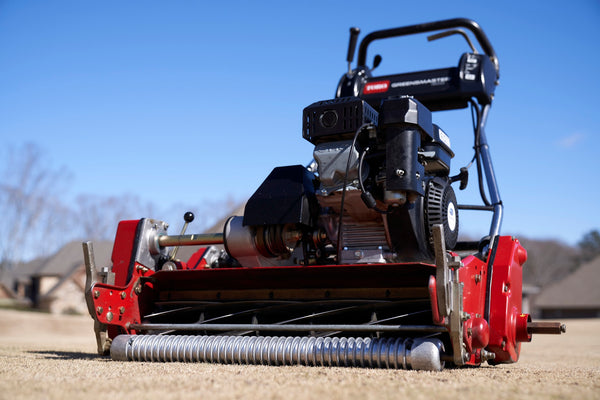
Clean your mower thoroughly: Before storing your lawnmower for the winter, clean it thoroughly. Remove grass clippings, dirt, and debris from the blades, deck, and undercarriage.
Inspect and sharpen blades: Check the condition of your lawnmower blades. If they are dull or damaged, sharpen or replace them as needed so you're ready for a clean cut in the spring.
Change the oil: If your lawnmower has a gas engine, change the oil before storing it for the winter. Old oil can become contaminated and lead to engine issues.
Stabilize fuel: If you have gasoline-powered equipment, add a fuel stabilizer to the gas tank and run the engine for a few minutes to ensure the stabilizer circulates through the fuel system. This prevents fuel from deteriorating and causing engine problems. For the last few mows of the season, it's also a great idea to switch to ethanol-free gasoline.
Disconnect the spark plug: For safety reasons, disconnect the spark plug wire to prevent accidental starts during storage.
Store indoors: Whenever possible, store your lawnmower indoors or in a sheltered area to protect it from the elements.
Storing and Protecting Garden Tools
Clean and oil hand tools: Clean your gardening hand tools, such as pruners, shears, and shovels. Apply a light coating of oil to metal parts to prevent rust.
Remove soil: Remove soil and debris from the blades and tines of shovels, rakes, and hoes to prevent rust and extend their lifespan.
Sharpen edges: Sharpen the edges of cutting tools like pruners, loppers, and hedge shears to ensure clean cuts in the spring.
Lubricate moving parts: Lubricate moving parts of hand tools, such as pivot points and joints, to keep them functioning smoothly.
Winter Care for Irrigation Equipment
Drain and store hoses: Drain garden hoses completely and store them coiled in a dry place. Water left in hoses can freeze and damage them.
Protect irrigation components: If you have above-ground irrigation components like sprinklers or hoses, store them indoors to prevent freezing and damage.
Properly maintaining your lawn equipment during the winter not only extends its lifespan but also saves you time and effort when you're ready to start your spring lawn care routine. By following these maintenance steps, you'll ensure that your tools and equipment are in optimal condition for the next season.
Winter Lawn Care Tips
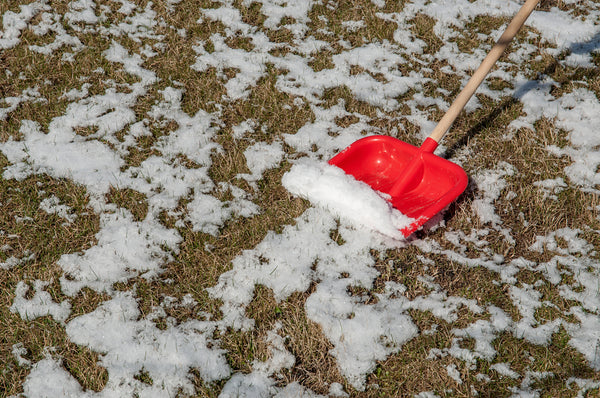
Winter lawn care involves more than just preparation; it also requires ongoing attention to protect your lawn from the harsh winter conditions.
Proper Snow Removal Techniques
Use snow blowers and shovels: Remove snow promptly to prevent it from compacting and causing damage. Use snow blowers or shovels to clear driveways, sidewalks, and paths. Be cautious not to throw snow onto your lawn, as it can smother the grass.
Avoid ice melt overuse: While ice melt products are effective for safety, excessive use can harm your lawn. Use them sparingly, and avoid products containing harmful chemicals like sodium chloride, which can damage grass.
Protecting Sensitive Plants and Shrubs
Mulch around plant bases: Apply a layer of mulch around the bases of trees, shrubs, and plants to protect their roots from freezing temperatures and fluctuations.
Use burlap or frost blankets: Wrap sensitive plants or shrubs with burlap or frost blankets to shield them from cold winds and frost.
Winter Lawn Monitoring and Adjustments
Monitor snow accumulation: Keep an eye on snow accumulation on your lawn. Heavy, wet snow can bend or break grass blades, while prolonged snow cover can lead to issues like snow mold.
Walk carefully on frozen grass: Avoid walking on frozen or snow-covered grass, as it can cause compaction and damage to the grass beneath.
Address winter weeds: If you notice winter weeds like poa annua, henbit, or chickweed, consider spot herbicide treatments or hand removal to prevent them from spreading in the spring.
Adjust watering when necessary: In regions with dry winter periods, water your lawn periodically if the ground becomes excessively dry. Proper moisture levels are crucial for the health of your grass.
Winter Lawn Inspections
Regularly inspect for pest damage: During mild winter spells, check your lawn for signs of pest or disease damage, such as voles or snow mold. Take action promptly if issues arise.
Plan for early spring care: Use the winter months to plan your early spring lawn care activities, such as overseeding, fertilization, and aeration. Being prepared will help you hit the ground running when the weather warms up.
Frequently Asked Questions about Lawn Winterization
Q: Is it necessary to winterize my lawn, or can I skip this step?
A: Winterizing your lawn is highly recommended, especially if you want to maintain a healthy and vibrant lawn year-round. Neglecting winter preparation can leave your grass vulnerable to cold stress, disease, and pest infestations. Proper winterization increases your lawn's resilience and ensures it looks its best when spring arrives.
Q: Can I apply regular fertilizer in the fall instead of winter fertilizer?
A: While regular fertilizer can provide some nutrients to your lawn, it's advisable to use a high potassium fertilizer in the late fall. This helps your lawn build energy reserves and improves cold tolerance without promoting excessive top growth.
Q: How often should I water my lawn in the winter?
A: The frequency of winter watering depends on your local climate and precipitation levels. In areas with dry winter conditions, water your lawn when the soil becomes dry to a depth of about 1 inch. Ensure the ground doesn't remain overly wet, but maintain adequate moisture to prevent desiccation.
Q: Are there any environmentally friendly alternatives to traditional ice melt products?
A: Yes, there are eco-friendly ice melt alternatives, such as calcium magnesium acetate (CMA) and potassium-based ice melt products. These options are less harmful to grass and the environment compared to traditional rock salt or sodium chloride.
Q: Can I perform aeration and overseeding in the spring instead of the fall?
A: While fall is the ideal time for cool-season grass aeration and overseeding, you can perform these tasks in the spring if necessary. Keep in mind that spring seeding may face more competition from weeds, and the grass may not establish as robustly as it would in the fall.
Q: What is the best way to prevent voles from damaging my lawn during the winter?
A: To prevent vole damage, keep your lawn clear of debris and tall grass where they can hide. Use physical barriers like fencing or tree guards to protect vulnerable plants and shrubs. Additionally, keeping your lawn well-maintained and regularly mowing it can deter voles from making runways.
Spring It On!
As winter approaches, it's time to put these measures in place to ensure your lawn remains resilient, healthy, and beautiful throughout the colder months. When spring arrives, you'll be greeted with a vibrant lawn that you can enjoy all season long. Happy winterizing!
Start preparing for spring lawn care and stock up in the winter. Browse our range of outstanding lawn care products.
